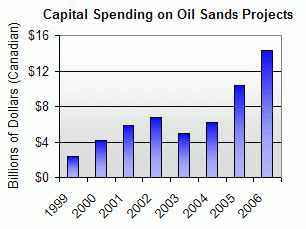
In the late 19th century, a handful of fur traders set up a trading post in a remote corner of northeastern Alberta. Those traders and their employer, Canada’s Hudson Bay Company, could have hardly imagined that their obscure outpost would one day become the very center of North America’s oil boom.
But it’s hard to ignore the transformation of Fort McMurray, Canada – a city so prosperous that it has been dubbed ‘Fort McMoney’ by local residents. Real estate prices have roughly tripled in the past seven years; the median price of a single family home stands at $650,000, up more than $150,000 in just the past year alone.
And with the vacancy rate on rental properties stubbornly stuck under 0.5%, entire extended families cram into small two-bedroom apartments. Others choose to rent campsites on the edge of the city to accommodate mobile homes. The town’s population has doubled in the past decade to 65,000 and is set to rise to more than 100,000 by the end of 2012.
So what’s the attraction of this remote city where temperatures regularly top out at less than zero degrees Fahrenheit?
It’s simple: cash.
The average salary in Fort McMurray stands at more than $125,000. And due to a shortage of workers, those salaries are rising fast.
According to a recent story in The Wall Street Journal, inexperienced truck drivers can earn more than $100,000 per year, while experienced welders can see their salaries top $200,000. On top of all that, companies are offering outlandish perks to attract skilled workers, including free housing, gourmet food and even free flights back to Canada’s more populous cities.
What’s driving this boom?
At the center of all of this prosperity sits as much as 1 trillion barrels of oil reserves locked in Canada’s vast oil sands. Fort McMurray is at the very heart of the Canadian oil sands, the fastest-growing part of the nation’s petroleum industry.
And Canada is an absolutely crucial player in the energy market. In fact, the nation is the United States’ single largest source of imported oil – more important to US oil supply than the entire Middle East.
Oil sands are a combination of a heavy, solid form of oil known as bitumen mixed with sand, water and dirt – producers heat the oil sands to separate the bitumen. After a handful of additional processing steps, bitumen can be used to make gasoline and other refined products, just like conventional crude oil.
Oil sands are not a new resource. Native Americans used the bitumen for centuries to waterproof their canoes, and early settlers actually burned the sands to produce heat. But for most of the 20th century, the big oil producers ignored the oil sands – the price of crude was simply too low and conventional oil deposits too abundant to make producing this resource economical.
But that’s changed.
With oil prices above $100 per barrel today, the oil sands are immensely profitable for producers. And as my charts show, investment and production are booming; oil sands production currently stands at more than 1.1 million barrels per day, more than one-third of Canada’s total.
By the end of 2010, oil sands production is expected to approach 2 million barrels per day, close to two-thirds of Canada’s total output. In fact, the main constraints on growth remain shortages of skilled labor and crucial equipment – the very shortages that have resulted in high salaries and economic boom times for Fort McMurray.
China looks to tap oil sands
The US is the primary destination for Canadian oil exports – currently, more than three-quarters of Canada’s exports go to the nation’s southern neighbor. But other countries are also interested in Canada’s natural riches. Chinese oil giant CNOOC made headlines in 2005 when it invested in a handful of oil sands projects. Chinese firms have already invested a total of $300 million in Canadian oil sands plays so far, and more investment is likely in the future. Clearly, this resource could be a valuable source of oil to fuel China’s growing demand.
And while many focus solely on the oil industry, Canada is also a crucial supplier of other natural resources. Canada remains the number one source of natural gas imports into the US market; Canadian production has been key to meeting rapid growth in US demand. And Canada also ranks as one of the world’s top five producers of commodities as diverse as copper, uranium, gold, silver, zinc and lumber. All of these resources are in high demand, particularly in fast-growing emerging markets like China and India.
Canadian stocks deliver +178% gains
Heavy exposure to commodity-related industries has been the key driver of outperformance for the Toronto Stock Exchange (TSX) in recent years. The TSX increased +178% from the end of 1999 through 2007, compared to just +3.7% for the S&P 500.
Looked at another way, a $100,000 investment in Canada back in late 1999 was worth $278,000 by the end of 2007, compared to just $103,700 for the same sized investment in the S&P 500. And over the past two years alone, the Canadian market has outperformed the S&P 500 by better than a 3-to-1 margin.
Meanwhile, the nation’s stable economic growth continues, with the Canadian economy expected to expand at a roughly +2.5% clip in the coming year – versus flat or possibly even negative growth in the US. Even the Canadian real estate market continues to boom despite weakness in the US – according to a recent survey released by RE/MAX, Canadian real estate prices are up +98.7% over the past decade, and prices continue to move higher. That’s by far the largest property boom in Canada’s history.
Bottom line – Canada’s resilient economic growth and vast natural resource wealth should continue for many years to come, leading to outsized profits for investors.
By Nick Lanyi for the Smart Profits e-Report, www.smartprofitsreport.com